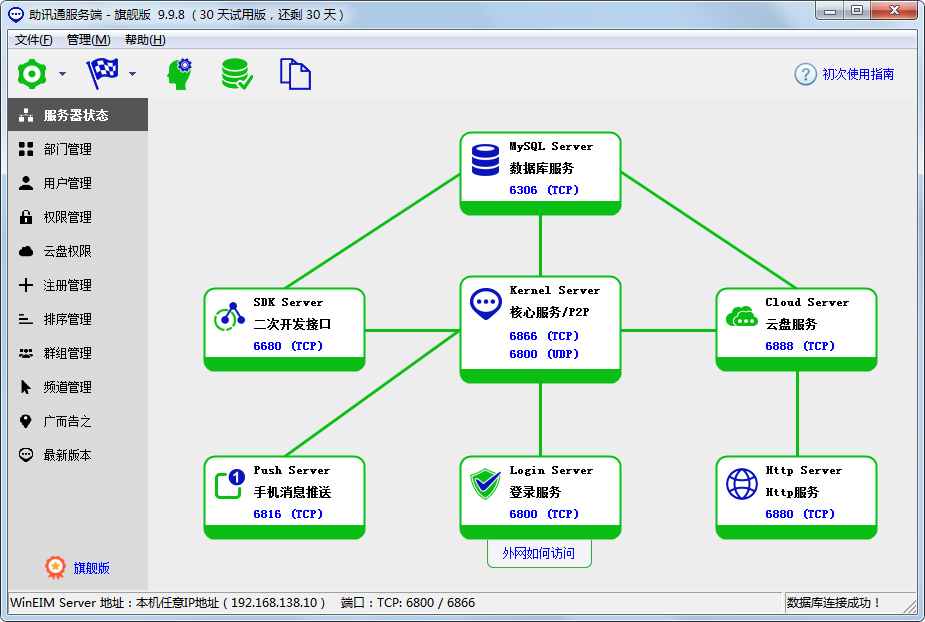转 mysql Next-Key Locking
时间:2022-03-14 15:05
原文:http://dev.mysql.com/doc/refman/5.5/en/innodb-next-key-locking.html
14.5.2.5 Avoiding the Phantom Problem Using Next-Key Locking
The so-called phantom problem occurs within a transaction when the same query produces different sets of rows at different times. For example, if a is executed twice, but returns a row the second time that was not returned the first time, the row is a “phantom” row.
Suppose that there is an index on the id column of the child table and that you want to read and lock all rows from the table having an identifier value larger than 100, with the intention of updating some column in the selected rows later:
SELECT * FROM child WHERE id > 100 FOR UPDATE;
The query scans the index starting from the first record where id is bigger than 100. Let the table contain rows
having id values of 90 and 102. If the locks set on the index records in the scanned range do not lock out inserts made in the gaps (in this case, the gap between 90 and 102), another session can insert a new row into the table with an id of 101. If you were to execute the same within the same transaction, you would see a new row with an id of 101 (a “phantom”) in the result set returned by the query. If we regard a set of rows as a data item, the new phantom child would violate the isolation principle of transactions that a transaction should be able to run so that the data it has read does not change during the transaction.
To prevent phantoms, InnoDB uses an algorithm called next-key locking that combines index-row locking with gap locking. InnoDB performs row-level locking in such a way that when it searches or scans a table index, it sets shared or exclusive locks on the index records it encounters. Thus, the row-level locks are actually index-record locks. In addition, a next-key lock on an index record also affects the “gap” before that index record. That is, a next-key lock is an index-record lock plus a gap lock on the gap preceding the index record. If one session has a shared or exclusive lock on record R in an index, another session cannot insert a new index record in the gap immediately before R in the index order.
When InnoDB scans an index, it can also lock the gap after the last record in the index. Just that happens in the preceding example: To prevent any insert into the table where id would be bigger than 100, the locks set by InnoDB include a lock on the gap following id value 102.
You can use next-key locking to implement a uniqueness check in your application: If you read your data in share mode and do not see a duplicate for a row you are going to insert, then you can safely insert your row and know that the next-key lock set on the successor of your row during the read prevents anyone meanwhile inserting a duplicate for your row. Thus, the next-key locking enables you to “lock” the nonexistence of something in your table.
Gap locking can be disabled as discussed in . This may cause phantom problems because other sessions can insert new rows into the gaps when gap locking is disabled.
14.5.2.4 InnoDB Record, Gap, and Next-Key Locks
InnoDB has several types of record-level locks including record locks, gap locks, and next-key locks. For information about shared locks, exclusive locks, and intention locks, see .
-
Record lock: This is a lock on an index record.
-
Gap lock: This is a lock on a gap between index records, or a lock on the gap before the first or after the last index record.
-
Next-key lock: This is a combination of a record lock on the index record and a gap lock on the gap before the index record.
Record Locks
Record locks always lock index records, even if a table is defined with no indexes. For such cases, InnoDB creates a hidden clustered index and uses this index for record locking. See .
Next-key Locks
By default, InnoDB operates in transaction isolation level and with the system variable disabled. In this case, InnoDB uses next-key locks for searches and index scans, which prevents phantom rows (see ).
Next-key locking combines index-row locking with gap locking. InnoDB performs row-level locking in such a way that when it searches or scans a table index, it sets shared or exclusive locks on the index records it encounters. Thus, the row-level locks are actually index-record locks. In addition, a next-key lock on an index record also affects the “gap” before that index record. That is, a next-key lock is an index-record lock plus a gap lock on the gap preceding the index record. If one session has a shared or exclusive lock on record R in an index, another session cannot insert a new index record in the gap immediately before R in the index order.
Suppose that an index contains the values 10, 11, 13, and 20. The possible next-key locks for this index cover the following intervals, where ( or ) denote exclusion of the interval endpoint and [ or ] denote inclusion of the endpoint:
(negative infinity, 10] (10, 11] (11, 13] (13, 20] (20, positive infinity)
For the last interval, the next-key lock locks the gap above the largest value in the index and the “supremum” pseudo-record having a value higher than any value actually in the index. The supremum is not a real index record, so, in effect, this next-key lock locks only the gap following the largest index value.
Gap Locks
The next-key locking example in the previous section shows that a gap might span a single index value, multiple index values, or even be empty.
Gap locking is not needed for statements that lock rows using a unique index to search for a unique row. (This does not include the case that the search condition includes only some columns of a multiple-column unique index; in that case, gap locking does occur.) For example, if the id column has a unique index, the following statement uses only an index-record lock for the row having id value 100 and it does not matter whether other sessions insert rows in the preceding gap:
SELECT * FROM child WHERE id = 100;
If id is not indexed or has a nonunique index, the statement does lock the preceding gap.
A type of gap lock called an insert intention gap lock is set by operations prior to row insertion. This lock signals the intent to insert in such a way that multiple transactions inserting into the same index gap need not wait for each other if they are not inserting at the same position within the gap. Suppose that there are index records with values of 4 and 7. Separate transactions that attempt to insert values of 5 and 6 each lock the gap between 4 and 7 with insert intention locks prior to obtaining the exclusive lock on the inserted row, but do not block each other because the rows are nonconflicting.
It is also worth noting here that conflicting locks can be held on a gap by different transactions. For example, transaction A can hold a shared gap lock (gap S-lock) on a gap while transaction B holds an exclusive gap lock (gap X-lock) on the same gap. The reason conflicting gap locks are allowed is that if a record is purged from an index, the gap locks held on the record by different transactions must be merged.
Gap locks in InnoDB are “purely inhibitive”, which means they only stop other transactions from inserting to the gap. Thus, a gap X-lock has the same effect as a gap S-lock.
Disabling Gap Locking
Gap locking can be disabled explicitly. This occurs if you change the transaction isolation level to or enable the system variable. Under these circumstances, gap locking is disabled for searches and index scans and is used only for foreign-key constraint checking and duplicate-key checking.
There are also other effects of using the isolation level or enabling : Record locks for nonmatching rows are released after MySQL has evaluated the WHERE condition. For UPDATE statements, InnoDB does a “semi-consistent” read, such that it returns the latest committed version to MySQL so that MySQL can determine whether the row matches the WHERE condition of the .



























